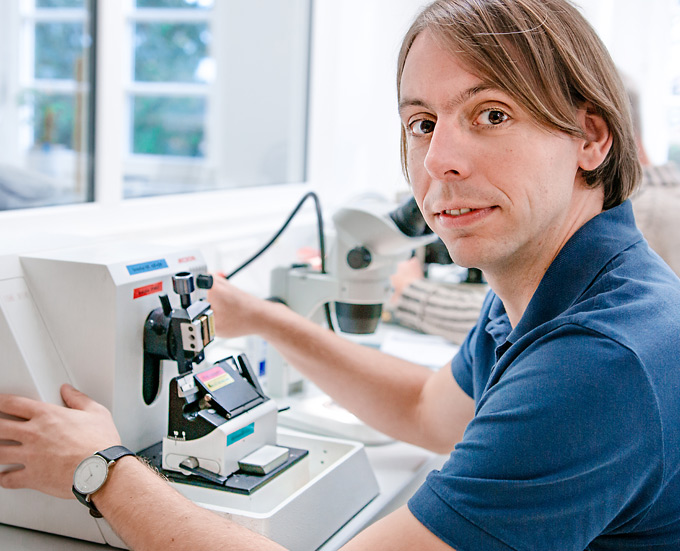Konformitäts-arbeit
Spezifische Migration (SML)/ NIAS- Screening/ Einzelstoffanalysen/ GC-MS-Analysen
Gesamtmigration (OML), Sensorik, Farblässigkeit, Mikrobiologie
Gutachten und Bewertungen (z.B. Schadensanalysen), Sonderprüfungen
Mechanische/ technologische Eigenschaften
Material-charakterisierung
Optische Eigenschaften
Permeation
Informationen zu einer Prüfung
Rollneigung oder Planlage
Die Rollneigung von flächigen Materialien hängt in der Regel von Temperatur und Konditionierungszustand ab. So können mehrschichtige Verbundmaterialien aus Materialien unterschiedlicher Wärmeausdehnungskoeffizienten oder Ausdehung/Schwindung auf Grund abweichender hygroskopischer Neigung durch eine Art Bi-Metall-Effekt Rollneigung zeigen. Außerdem können überhöhte mechanische Belastungen bei der Verarbeitung von Rollenware zu Rollneigung führen.
| Prüfmethodengruppe: | Mechanische/ technologische Eigenschaften |
| Normen: |
DIN 55403 (2014-07) |
| Erforderliche Probenmenge: | Kleinrolle (wenn nicht verfügbar: Folienschwarte oder Handrolle ohne Falten, Knicke und Verschmutzungen) |
Standardprüfungen
Planlage: KreuzschnittverfahrenDiese Methode differenziert bei starker Rollneigung besser als die methodisch ähnliche Rondenmethode. Es wird ein diagonaler Kreuzschnitt in die Folie eingebracht und die Probe gelagert. Notiert werden die Wölbrichtung und der Abstand der Keuzschnittspitzen in [mm]. Die Messungen erfolgen im Normklima bei 23°C und 50 % relative Feuchte und sind gut geeignet für Materialvergleiche. Messungen bei abweichenden Klimabedingungen gegen Aufpreis möglich, sprechen sie uns an.
Norm: DIN 55403
Planlage: Planlagetemperatur
Mit dieser Methode wird die Planlagetemperatur ermittelt. Der Test ist sinnvoll zur Prüfung von Mehrschichtfolien, bei denen die Einzellagen aus Materialien mit unterschiedlichen Wärmeausdehungskoeffizienten bestehen. Dieses kann bei Temperaturschwankungen zu Rollneigungen führen ("Bimetalleffekt").
Norm: DIN 55403
Planlage: Rondenmethode
Eine Ronde mit Durchmesser 113 mm wird gelagert, die Wölbrichtung notiert und der Kantenabstand in [mm] gemessen. Die Messungen erfolgen im Normklima bei 23°C und 50 % relative Feuchte und sind gut geeignet für Materialvergleiche. Messungen bei abweichenden Klimabedingungen gegen Aufpreis möglich, sprechen sie uns an.
Norm: DIN 55403
Zurück zur Übersicht der Prüfmethode Mechanische/ technologische Eigenschaften
Prüfungen suchen
Ihr Ansprechpartner
 Matthias Böhne
Matthias Böhne
Prüfungen in diesem Bereich
- Abrieb/Scheuertest von Bedruckungen nach Dr. Ruf
- Antitau- (Antifog-) Test
- Benetzungsspannung (z. B. zur Beurteilung der Corona-Vorbehandlungsintensität)
- Berstfestigkeit nach Mullen an Papier
- Bewertung von Planlage, Bogenlauf und Faltenbildung an Kunststofffolien- Streifenmethode
- Bewitterungsprüfung - Nasswischfestigkeit bedruckter Torf-, Substrat- und Humusverpackungen
- Biegesteifigkeit
- Blocktest/Blockkraft
- Bogenlauf (Sichellauf) von Folien
- Charakterisierung von Reckhauben- und Wickelstretchfolien durch Hysteresezugversuch (nur in Reckrichtung)
- Dickenmessung an Kunststofffolien, Aluminiumfolien, flächigen Verbundmaterialien, Platten
- Druckfarben und Lacke - Echtheit;Eignungstests, Beständigkeit, Alkali- Heißbeständigkeit
- Druckfarbenhaftung (Tesa Test)
- Durchreiß-/Weiterreißwiderstand (Elmendorf)
- Durchstoßprüfung, quasistatisch (Temperaturbereich - 40 bis + 120 °C)
- Eindruckhärte (Shore-Härte)
- Entstapelbarkeit von Bechern (Hohlkörpern)
- Falltest von Säcken und Beuteln
- Fettabweisende Imprägnierung von Papier, Prüfung auf lipophobe Eigenschaften, KIT-Test
- Fettdurchlässigkeit/Fettdichte
- FINAT Klebkraft Prüfung
- Flächengewicht/ flächenbezogene Masse, Ergiebigkeit
- Formatmessungen und Rapportmessungen an Beuteln, Säcken etc.
- Gelboflextest/Brugger KFT
- Gewichtsbestimmung
- Glätte nach Bekk
- Lagerversuch im Klimaraum unter Normklima 23°C/ 50 % r.F.
- Lagerversuch/ beschleunigte Alterung im Wärme- oder Kühlschrank (geregelte Temperatur)
- Lagerversuch/ beschleunigte Alterung in explosionsgeschützer Wärmekammer (geregelte Temperatur)
- Lagerversuch/beschleunigte Alterung in Klimakammer (geregelte Temperatur und relative Feuchte)
- Lichtechtheit von Bedruckungen/ Wollskala - künstliches Bestrahlen mit gefilterter Xenonbogenstrahlung
- Luftdurchlässigkeit nach Gurley
- Maßänderung/Maßhaltigkeit/Wärmestabilität/Dimensionsstabilität von Folien und Bahnen
- Oberflächenhaftung/Cling von Stretchfolien, landwirtschaftlichen Stretchfolien, Catering-Folien, Frischhaltefolien und anderen Wickelstretchfolien
- Oberflächenwiderstand/spezifischer Oberflächenwiderstand
- Rauhigkeit nach Bendtsen
- Reibungskoeffizient COF
- Rollneigung oder Planlage
- Scherfestigkeit von Klebenähten (Temperaturbereich - 40 bis +120° C)
- Schlagfestigkeit nach dem Fallhammerverfahren (Dart Drop), Eingrenzungsverfahren
- Schlagfestigkeit nach dem Fallhammerverfahren- Durchstoßversuch mit elektronischer Messwerterfassung
- Schlagzugzähigkeit
- Schrumpfweg von PE-Folien (Betex-Gerät)
- Siegel-/ Schweißeigenschaften von Folien, Überprüfung und Vergleich mit Laborsiegelpresse
- Siegel-/ Schweißnahtfestigkeit, Streifenzugversuch (Temperaturbereich -40 bis +120 °C)
- Siegel-/Schweißeigenschaften von Folien/Hot-Tack-Test von Folien
- Siegelbeständigkeit von Bedruckungen oder Lackierungen/Übersiegelbarkeit (Hitzebständigkeit)
- Siegelnahtfestigkeit von peelfähigen Beuteln, Säcken, versiegelten Packungen mit Packungsprüfvorrichtung zur Bestimmung der Öffnungskräfte
- Siegelnahtgüte von PE-Beuteln oder Säcken (Temperaturbereich -40 bis +120 °C)
- Stauchversuch an Bechern, Schalen (Temperaturbereich - 40 bis + 120 °C)
- Sterilisation/Pasteurisation im Laborautoklaven
- Verbundhaftung/Schälkraft von Laminaten/Mehrschichtfolien/Verklebungen (Temperaturbereich - 40 bis + 120 °C)
- Volumenbestimmug von Tragetaschen und Beuteln
- Wasseraufnahme von Papier/Cobb-Test
- Weiterreiß-/Durchreißwiderstand (auch Falzkanten), (Temperaturbereich - 40 bis + 120 °C)
- Zeitstandversuch/Kriechversuch
- Zugversuch Aluminiumfolien
- Zugversuch Folien und Laminate (Temperaturbereich -40 bis +120 °C)
- Zugversuch Papier Nassbruchkraft
- Zugversuch Papier, Siegelnahtfestigkeit von Papiermustern
© 2024 Innoform GmbH Testservice

